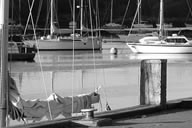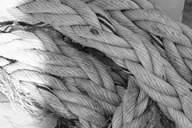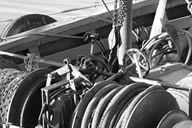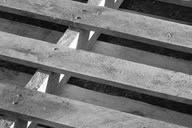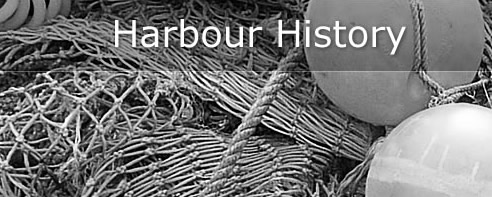
Tarbert Harbour History
History Of Tarbert Harbour
The small inlet of Loch Fyne, known as East Loch Tarbert, has been used as a sheltering place for over a thousand years. Even before Magnus Bareleg negotiated the isthmus, fisherman and traders alike, used this landlocked harbour. Variously described as "peaceful", "picturesque", "bustling" or merely "a curious little bay" it is undoubtedly the main factor in Tarberts existence.
Robert the Bruce in the 1320's is reported to have arrived for his periodic sojourns in "the King's Great Ship". In the Exchequer Roll for Scotland in 1328, a fee of 7/8 is recorded as paid for the making of a "coket" for the Burgh of Tarbert. This was to be used in connection with a levy on goods despatched through the Port. Over a century later James IV provisioned Tarbert's Castle with guns and smmunition, delivered by SHip. Even in these early times Tarbert's Harbour was well used.
Recognition of its importance was further reinforced in the reign of Queen Anne by an Act of Parliament in 1708, which empowered the local landowner, Archibald Mackalaster, along with the three Justices of the Peace nearest to Tarbert, and the Sheriff Principal of the Shire "to make and keep in good repair, a harbour or key at East tarbert along with such wharves and buildings as may be thought necessary...for the anchoring of all shipps and boates...and for the landing and laying any fish or merchandizes...". Under the above Act, Archibald Mackalaster was granted right to charge "all persons and masters of vessels using the harbour and its facilities". Such revenues thus raised, were to be applied to the "makeing, amending and maintaining the said harbour and key or East Tarbett".
A decline in the fortunes of the MacAlister family results in Archibald Campbell of Stonefield, purchasing the Tarbert Estates in 1746, along with the rights and titles pertaining thereto.
The nineteenth century sees Tarbert beginning to take on the appearance of the town we know today. In 1809 a memorial was presented to the Parliamentary Commissioners to persuade the Government to undertake the renewal of the land breast (originally constructed by the Proprietor) and the enlargement of the Quay. Although the population of Tarbert was still less than 1,000 souls at this time, the village was recognised as "one of the most considerable places in the West Highlands on account of the excellence of its harbour". The proposed works were undertaken shortly thereafter, opening the way for the subsequent development of Harbour Street. Improvements to the harbour entrance were made at the same time, by the removeal of some large rocks. The present breast wall is largely unaltered since that date.
With the advent of steam passenger ships a pier was required to be built at the outer harbour. These vessels were unable to safely naviagate the narrow entrance channel to the inner quayside. An attempt to build a concrete pier at Mealldarroch Bay ended in failure when a storm destroyed it before it came into use. Little remains to be seen today, but "Glendarroch" a house which stands nearby was the intended residence of the Harbour Master.
A wooden landing place was subsequently built around 1870 in a more sheltered position. The fine villas on Pier Road were put under construction shortly after its opening. Later extended and recently subject to a major repair this Pier is still in regular use. At the beginning of the 20th Century the Harbour Act of 1708 required revision to take account of the changes of the previous 200 years. A petition was submitted to Parliament by the then landowner, Colin George Pelham Campbell of Stonefield, along with John Mcleod, Ironmonger, Neil Murray, Fisherman, Neil Black, Merchant, and David Hope MacBrayne, Shipowner, 119 Hope Street, Glasgow, resulting in the current Tarbert (Loch Fyne) Harbour Order 1912.
The "Limite" within which authority may be exercised, are defined as "the Loch called East Loch Tarbert, from the point of Garvell on the North, to the Oakenhead or Rudha Loigste point on the South". Within this area the many and varied powers which are available to the Trustees, include laying of rail and tramways, leasing of pavilions, shops, sheds or other buildings, dredging, provision of ferry boats, levying of rates and drawing up of Byelaws. Failure by harbour users to pay the relevant dues may incur additional penalties, and the Harbour Master is authorised to prevent any vessel from leaving Port until the necessary payments have been made.
The 1708 Queen Anne Act stipulated that revenues raised should be applied to the improvement and maintenance of the harbour. This stricture is still in force.
Many schemes were undertaken in the past by the "Proprietors" (Campbell Of Stonefield), such as the "new" breast wall, extension of the quay, and a road to service the new steamer Pier. The Harbour Trust formed by the Act of 1912, has continued this work.
In the 1930's. breastworks were built below Barmore Road, creating a small promenade. Over the years various other land works have been undertaken as well as dredging to create more deep water areas. The large herring landings of the 1940's, 50's and 60's contributed to periodic improvements, to make today's extensive and well constructed quay. Major works have recently brought fish landing and market facilities to modern standards. Despite the decline in the fortunes of the fishing industry Tarbert is still the base for a modest fishing fleet, carrying on the tradition of centuries. Hopefully "fishing" will continue to play an important part in the village economy for many years to come.
The steamer (East) Pier has also been the subject of restoration work. The recent repairs ensure that the Pier can remain in use for a further twenty years at least. Increased visits by pleasure steamers and other vessels have justified the expenditure incurred.
The 1994 link between Tarbert and the Cowal Peninsula was re-established. The necessary slipway infrastructure was funded by Argyll and Islands Enterprise and a summer car farry service operated by Caledonian MacBrayne. Such was its success that all expectations were exceeded. A demand is evident for an all year round service.
The current interest in yachting and an increasing demand for marine orientated leisure facilities, has not been ignored by the Tarbert Harbour Trustees. The past fifteen years have seen the introduction of pontoon berthing with later additions to the original installation. Car Parking and more recently a toilet and shower block have also been provided, making Tarbert a popular destination for ever greater numbers of pleasure craft.
The Trustees policy of improving facilities whilst holding charges to a minimum has no doubt contributed to an over-subscription for the available permanent berthing spaces. Tarbert is regularly used as a base for several high profile yacht races.
A Harbour Development Study commissioned by Tarbert Harbour Authority in conjunction with Argyll and The Islands Enterprise has identified the likely future requirements of the various interests. The study also offers a number of solutions to satisfy the perceived future demands of both commercial and leisure users. However, any extensive harbour development will require to be planned with care and considerable sympathy. The need for further improvements must be tempered by safeguards for the unique features of the town and its bay.
Tarbert Loch Fyne - A History of its Harbour by Ian Y. MacIntyre (1995)
